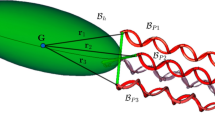Abstract
A new type of propeller that is optimized for low Reynolds numbers is required to propel a small object in a medium where the flow is dominated by viscous rather than inertial forces. A propeller in the shape of a bacterial flagellum seems an appropriate choice for driving a small object. Accordingly, in this study, we visualized the velocity field induced by a spring-like propeller inspired by the Escherichia coli flagellum, using a macroscopic model and applying stereoscopic particle image velocimetry. We also experimentally evaluated the effect of pitch and rotational speed on the performance of this flagellar propeller. Silicone oil, which has a kinematic viscosity 100,000 times that of water, was used as the working fluid to generate a low Reynolds number for the macroscopic model. Thrust, torque, and velocity were measured as functions of pitch and rotational speed, and the efficiency of the propeller was calculated from the measured results. We found that the flagellar propeller reached a maximum efficiency when the pitch angle was approximately 53°. Compared to pitch, rotational speed had a relatively small effect on the efficiency, and the pitch altered the flow pattern behind the rotating propeller.
Similar content being viewed by others
References
Lauga E, Powers T R. The hydrodynamics of swimming microorganism. Reports on Progress in Physics, 2009, 72, 096601.
Gray J, Hancock G. The propulsion of sea-urchin spermatozoa. Journal of Experimental Biology, 1955, 32, 802–814.
Higdon J J L. The hydrodynamics of flagellar propulsion: Helical waves. Journal of Fluid Mechanics, 1979, 94, 331–351.
Chen B, Liu Y, Chen S, Jiang S, Wu H. A biomimetic spermatozoa propulsion method for interventional micro robot. Journal of Bionic Engineering, 2008, 5, 106–112.
Behkam B, Sitti M. Design methodology for biomimetic propulsion of miniature swimming robots. Journal of Dynamic Systems, Measurement, and Control, 2006, 128, 36–43.
Behkam B, Sitti M. E. coli inspired propulsion for swimming microrobots. ASME 2004 International Mechanical Engineering Congress and Exposition (IMECE2004), Anaheim, USA, 2004, 1037–1041.
Gebremichael Y, Ayton G S, Voth G A. Mesoscopic modeling of bacterial flagellar microhydrodynamics. Biophysical Journal, 2006, 91, 3640–3652.
Kim M J, Kim M J, Bird J C, Park J, Powers T R, Breuer K S. Particle image velocimetry experiments on a macro-scale model for bacterial flagellar bundling. Experiments in Fluids, 2004, 37, 782–788.
Sakar M S, Lee C, Arratia P E. Flagellar dynamics in viscous fluids. Physics of Fluids, 2009, 21, 091107.
Kim M J, Bird J C, Van Parys A J, Breuer K S, Powers T R. A macroscopic scale model of bacterial flagellar bundling. Proceedings of the National Academy of Sciences, 2003, 100, 15481–15485.
Raffel M, Willert C, Wereley T, Kompenhans J. Particle Image Velocimetry: A Particle Guide, 2nd, Springer, New York, 2007, 211–221.
Lawson N J, Wu J. Three-dimensional particle image velocimetry: Error analysis of stereoscopic techniques. Measurement Science and Technology, 1997, 8, 894–900.
Chattopadhyay S, Moldovan R, Yeung C, Wu X L. Swimming efficiency of bacterium Escherichia coli. Proceedings of the National Academy of Sciences, 2006, 103, 13712–13717.
Higdon J J L. A hydrodynamic analysis of flagellar propulsion. Journal of Fluid Mechanics, 1979, 90, 685–711.
Zhang L, Peyer K E, Nelson B J. Artificial bacterial flagella for micromanipulation. Lab on a Chip, 2010, 10, 2203–2215.
Purcell E M. The efficiency of propulsion by a rotating flagellum. Proceedings of the National Academy of Sciences of the United States of America, 1997, 94, 11307–11311.
Spagnolie S E, Lauga E. Comparative hydrodynamics of bacterial polymorphism. Physical Review Letters, 2011, 106, 058103.
Dominik J B, Dong L, Nelson B J, Golling M, Zhang L, Grützmacher D. Fabrication and characterization of three-dimensional InGaAs/GaAs nanosprings. Nano Letters, 2006, 6, 725–729.
Zhang L, Elisabeth R, Grützmacher D, Dong L, Bell D J, Nelson B J, Schönenberger C. Anomalous coiling of SiGe/Si and SiGe/Si/Cr helical nanobelts. Nano Letters, 2006, 6, 1311–1317.
Zhang L, Abbott J J, Dong L, Kratochvil B E, Nelson B J. Artificial bacterial flagella: Fabrication and magnetic control. Applied Physics Letters, 2009, 94, 064107.
Zhang L, Abbott J J, Dong L, Peyer K E, Kratochvil B E, Zhang H, Bergeles C, Nelson B J. Characterizing the swimming properties of artificial bacterial flagella. Nano Letters, 2009, 9, 3663–3667.
Ghosh A, Fischer P. Controlled propulsion of artificial magnetic nanostructured propellers. Nano Letters, 2009, 9, 2243–2245.
Author information
Authors and Affiliations
Corresponding author
Rights and permissions
About this article
Cite this article
Jeon, H., Kim, YC., Yim, D. et al. Flow visualization and performance measurements of a flagellar propeller. J Bionic Eng 9, 322–329 (2012). https://doi.org/10.1016/S1672-6529(11)60119-4
Published:
Issue Date:
DOI: https://doi.org/10.1016/S1672-6529(11)60119-4




